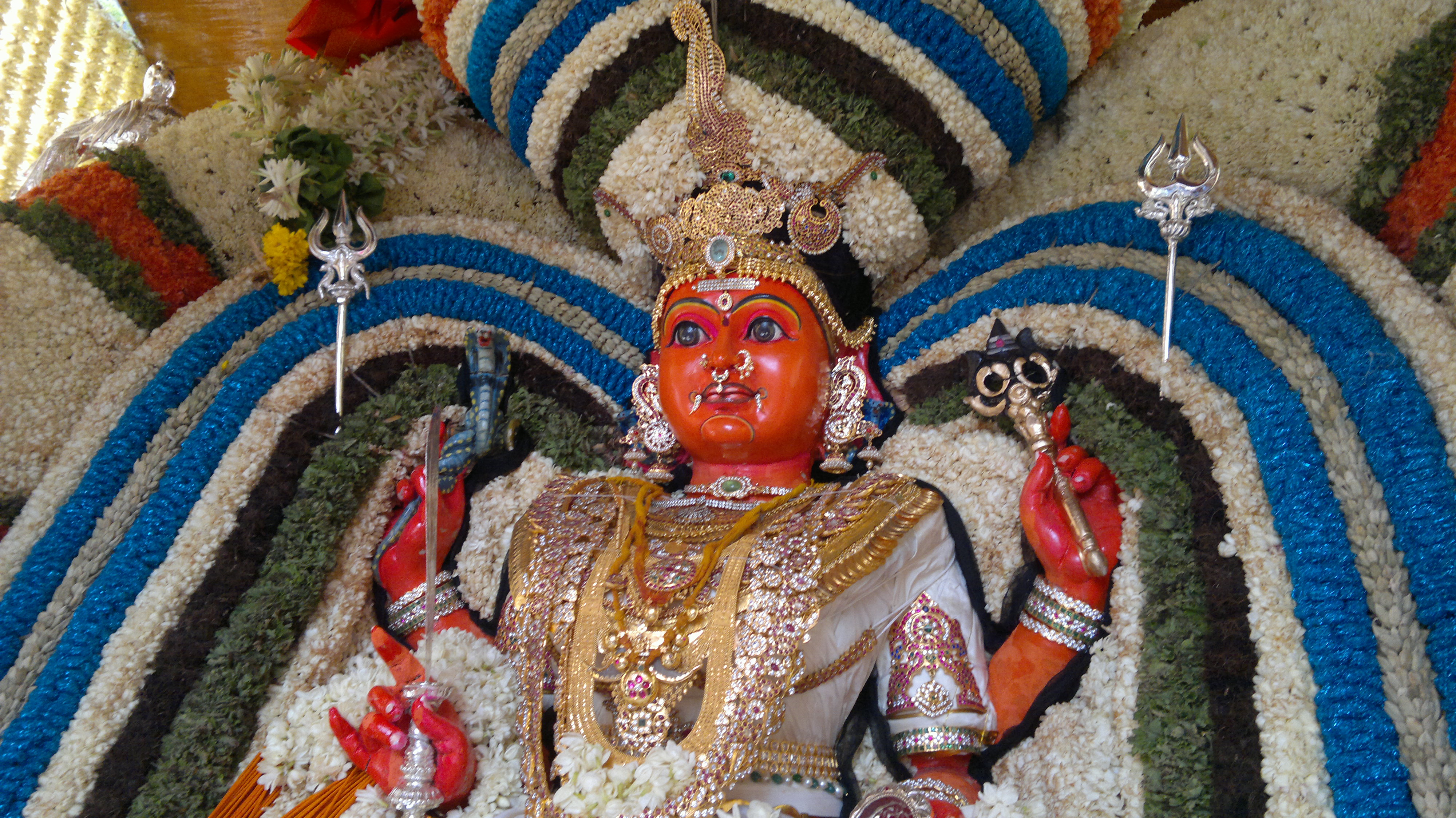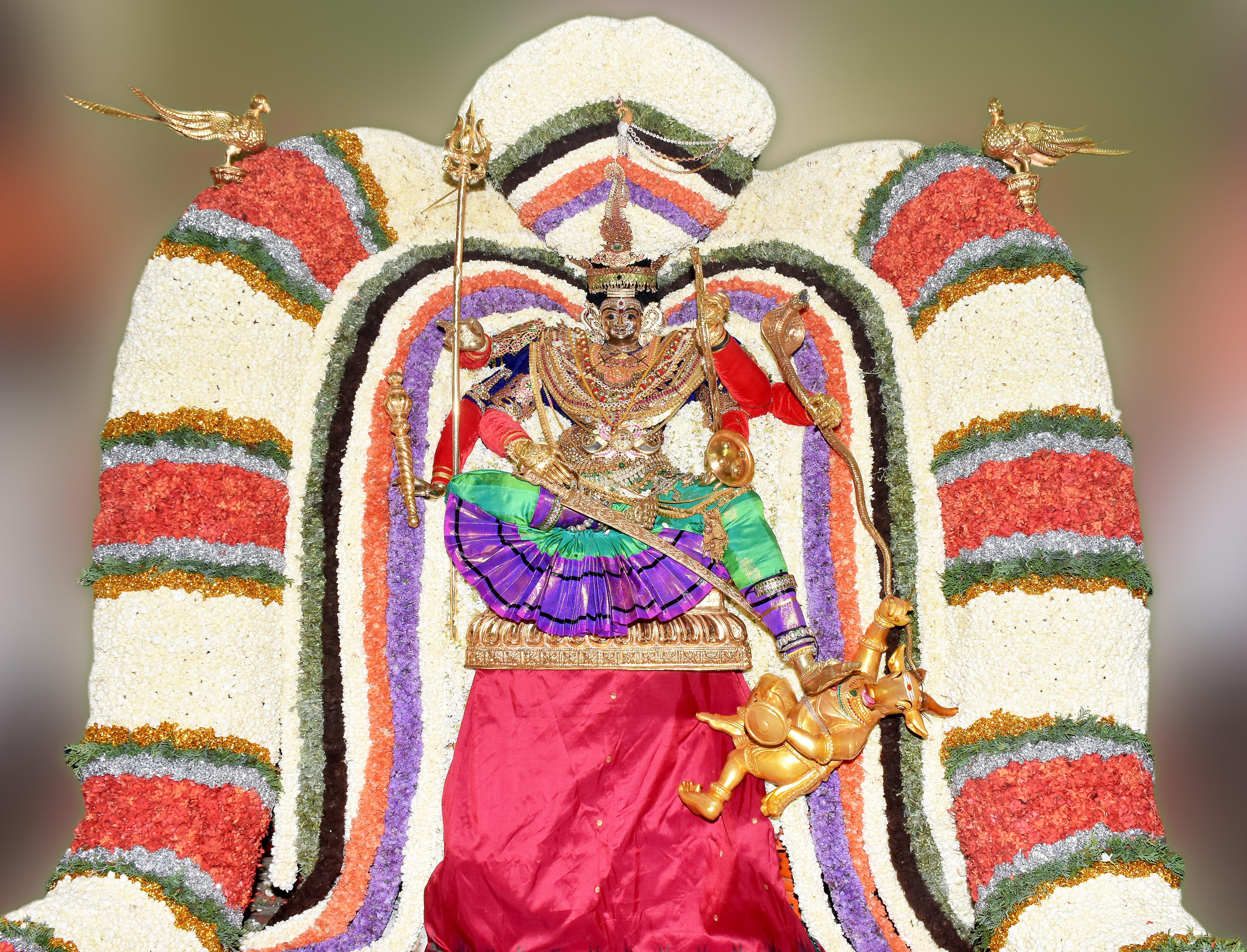
Vinayagar Alangaram










About Vinayagar/Ganesha in Wikipedia
Ganesha (/ɡəˈneɪʃə/; Sanskrit: गणेश, Gaṇeśa; About this sound listen (help·info)), also known as Ganapati, Vinayaka, Pillaiyar and Binayak, is one of the best-known and most worshipped deities in the Hindu pantheon. His image is found throughout India, Sri Lanka, Thailand, and Nepal. Hindu denominations worship him regardless of affiliations. Devotion to Ganesha is widely diffused and extends to Jains and Buddhists.
Although he is known by many attributes, Ganesha's elephant head makes him easy to identify. Ganesha is widely revered as the remover of obstacles, the patron of arts and sciences and the deva of intellect and wisdom. As the god of beginnings, he is honoured at the start of rites and ceremonies. Ganesha is also invoked as patron of letters and learning during writing sessions. Several texts relate mythological anecdotes associated with his birth and exploits and explain his distinct iconography.
Ganesha likely emerged as a deity as early as the 2nd century AD, but most certainly by the 4th and 5th centuries AD, during the Gupta period, although he inherited traits from Vedic and pre-Vedic precursors. Hindu mythology identifies him as the restored son of Parvati and Shiva of the Shaivism tradition, but he is a pan-Hindu god found in its various traditions. In the Ganapatya tradition of Hinduism, Ganesha is the supreme deity. The principal texts on Ganesha include the Ganesha Purana, the Mudgala Purana, and the Ganapati Atharvashirsa. Brahma Purana and Brahmanda Purana are other two Puranic genre encyclopedic texts that deal with Ganesha.
Sivan Alangaram






About Sivan in Wikipedia
Shiva (/ˈʃiːvə, ˈʃɪ-/; Sanskrit: शिव, IAST: Śiva, lit. the auspicious one) is one of the principal deities of Hinduism. He is the Supreme Being within Shaivism, one of the major traditions within contemporary Hinduism.
Shiva is the "destroyer of evil and the transformer" within the Trimurti, the Hindu trinity that includes Brahma and Vishnu. In Shaivism tradition, Shiva is the Supreme being who creates, protects and transforms the universe. In the goddess tradition of Hinduism called Shaktism, the goddess is described as supreme, yet Shiva is revered along with Vishnu and Brahma. A goddess is stated to be the energy and creative power (Shakti) of each, with Parvati the equal complementary partner of Shiva. He is one of the five equivalent deities in Panchayatana puja of the Smarta tradition of Hinduism.
According to the Shaivism sect, the highest form of Shiva is formless, limitless, transcendent and unchanging absolute Brahman, and the primal Atman (soul, self) of the universe. Shiva has many benevolent and fearsome depictions. In benevolent aspects, he is depicted as an omniscient Yogi who lives an ascetic life on Mount Kailash as well as a householder with wife Parvati and his two children, Ganesha and Kartikeya. In his fierce aspects, he is often depicted slaying demons. Shiva is also known as Adiyogi Shiva, regarded as the patron god of yoga, meditation and arts.
The iconographical attributes of Shiva are the serpent around his neck, the adorning crescent moon, the holy river Ganga flowing from his matted hair, the third eye on his forehead, the trishula as his weapon and the damaru. He is usually worshipped in the aniconic form of Lingam. Shiva is a pan-Hindu deity, revered widely by Hindus, in India, Nepal and Sri Lanka.
Perumal Alangaram
















About Perumal/Vishnu in Wikipedia
Vishnu (/ˈvɪʃnuː/; Sanskrit pronunciation: [vɪʂɳu]; Sanskrit: विष्णु, IAST: Viṣṇu) is one of the principal deities of Hinduism, and the Supreme Being in its Vaishnavism tradition. Vishnu is the "preserver" in the Hindu trinity (Trimurti) that includes Brahma and Shiva.In Vaishnavism, Vishnu is identical to the formless metaphysical concept called Brahman, the supreme, the Svayam Bhagavan, who takes various avatars as "the preserver, protector" whenever the world is threatened with evil, chaos, and destructive forces. His avatars most notably include Rama in the Ramayana and Krishna in the Mahabharata. He is also known as Narayana, Jagannath, Vasudeva, Vithoba, and Hari. He is one of the five equivalent deities worshipped in Panchayatana puja of the Smarta Tradition of Hinduism.
In Hindu iconography, Vishnu is usually depicted as having a dark, or pale blue complexion and having four arms. He holds a padma (lotus flower) in his lower left hand, Kaumodaki gada (mace) in his lower right hand, Panchajanya shankha (conch) in his upper left hand and the Sudarshana Chakra (discus) in his upper right hand. A traditional depiction is Vishnu reclining on the coils of the serpent Shesha, accompanied by his consort Lakshmi, as he "dreams the universe into reality".
Murugan Alangaram






About Murugan/Kandan in Wikipedia
Kartikeya (IAST: Kārttikēya), also known as Murugan, Skanda, Kumara, and Subrahmanya, is the Hindu god of war. He is the son of Parvati and Shiva, brother of Ganesha, and a god whose life story has many versions in Hinduism. An important deity around South Asia since ancient times, Kartikeya is particularly popular and predominantly worshipped in South India and Sri Lanka as Murugan.Kartikeya is an ancient god, traceable to the Vedic era. Archaeological evidence from 1st-century CE and earlier, where he is found with Hindu god Agni (fire), suggest that he was a significant deity in early Hinduism. He is found in many medieval temples all over India, such as at the Ellora Caves and Elephanta Caves.
The iconography of Kartikeya varies significantly; he is typically represented as an ever-youthful man, riding or near a peacock, dressed with weapons sometimes near a rooster. Most icons show him with one head, but some show him with six heads reflecting the legend surrounding his birth where six mothers symbolizing the six stars of Pleiades cluster who took care of newly born baby Kartikeya. He grows up quickly into a philosopher-warrior, destroys evil in the form of demon Taraka, teaches the pursuit of ethical life and the theology of Shaiva Siddhanta. He has inspired many poet-saints, such as Arunagirinathar.
Kartikeya, as Murugan or Subrahmanya, is found as a primary deity in temples wherever communities of the Tamil people live worldwide, particularly in Sri Lanka, Mauritius, Indonesia, Malaysia, Singapore, South Africa and Réunion. Three of the six richest and busiest temples in Tamil Nadu are dedicated to him. The Kataragama temple dedicated to him in Sri Lanka attracts Tamils, Sinhalese people and the Vedda people. He is also found in other parts of India, sometimes as Skanda, but in a secondary role along with Ganesha, Parvati and Shiva.
Amman Alangaram




































































About Amman/Devi/Mata in Wikipedia
Devī (Sanskrit: देवी) is the Sanskrit word for "goddess"; the masculine form is Deva. Devi – the feminine form, and Deva – the masculine form, mean "heavenly, divine, anything of excellence", and are also gender specific terms for a deity in Hinduism.
The concept and reverence for goddesses appears in the Vedas, which were composed in the 2nd millennium BCE; however, they do not play a central role in that era. Goddesses such as Saraswati and Usha have continued to be revered into the modern era. The medieval era Puranas witnessed a major expansion in mythology and literature associated with Devi, with texts such as the Devi Mahatmya, wherein she manifests as the ultimate truth and supreme power, and she has inspired the Shaktism tradition of Hinduism.
The divine feminine has the strongest presence as Devi in Hinduism, among major world religions, from the ancient times to the present. The goddess is viewed as central in Shakti and Saiva Hindu traditions.


